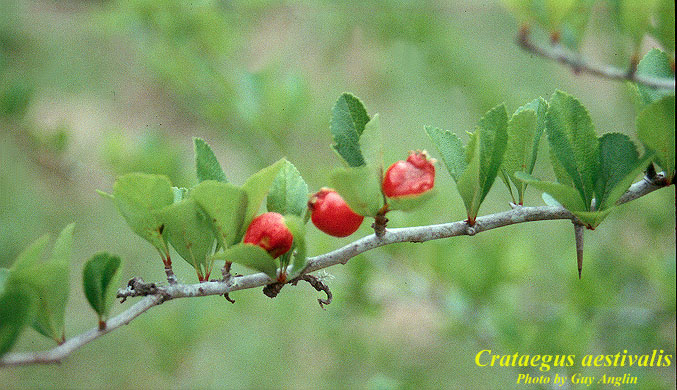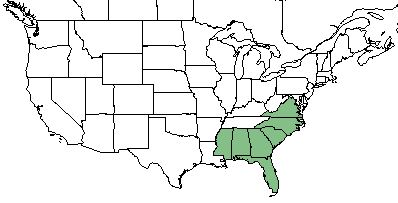Difference between revisions of "Crataegus aestivalis"
(→Distribution) |
|||
| Line 31: | Line 31: | ||
==Ecology== | ==Ecology== | ||
===Habitat=== <!--Natural communities, human disturbed habitats, topography, hydrology, soils, light, fire regime requirements for removal of competition, etc.--> | ===Habitat=== <!--Natural communities, human disturbed habitats, topography, hydrology, soils, light, fire regime requirements for removal of competition, etc.--> | ||
| + | ''C. aestivalis'' is most often found in swamp forests, generally where flooded for much of the year, often flowering and fruiting while standing in water, and occasionally growing as groves or stands in ‘mayhaw flats’. <ref name= "Weakley 2015"> Weakley, A. S. (2015). Flora of the Southern and Mid-Atlantic States. Chapel Hill, NC, University of North Carolina Herbarium. </ref> | ||
<!--===Phenology===--> <!--Timing off flowering, fruiting, seed dispersal, and environmental triggers. Cite PanFlora website if appropriate: http://www.gilnelson.com/PanFlora/ --> | <!--===Phenology===--> <!--Timing off flowering, fruiting, seed dispersal, and environmental triggers. Cite PanFlora website if appropriate: http://www.gilnelson.com/PanFlora/ --> | ||
| + | ''C. aestivalis'' flowers in February, March, and May. <ref name= "PanFlora"> PanFlora Author: Gil Nelson URL: [http://www.gilnelson.com/PanFlora/ http://www.gilnelson.com/PanFlora/] Date Accessed: 5/18/18 </ref> | ||
<!--===Seed dispersal===--> | <!--===Seed dispersal===--> | ||
<!--===Seed bank and germination===--> | <!--===Seed bank and germination===--> | ||
| − | + | ===Fire ecology=== <!--Fire tolerance, fire dependence, adaptive fire responses--> | |
| + | ''C. aestivalis'' is not fire resistant, and has a low fire tolerance. <ref name= "USDA Plant Database"/> | ||
<!--===Pollination===--> | <!--===Pollination===--> | ||
| − | + | ===Use by animals=== <!--Herbivory, granivory, insect hosting, etc.--> | |
| + | ''C. aestivalis'' is highly palatable to browsing animals, not highly palatable to grazing animals, and not palatable to humans. <ref name= "USDA Plant Database"/> | ||
<!--==Diseases and parasites==--> | <!--==Diseases and parasites==--> | ||
Revision as of 19:52, 18 May 2018
| Crataegus aestivalis | |
|---|---|

| |
| Photo by the Atlas of Florida Plants Database | |
| Scientific classification | |
| Kingdom: | Plantae |
| Division: | Magnoliophyta - Flowering plants |
| Class: | Magnoliopsida - Dicots |
| Order: | Rosales |
| Family: | Rosaceae |
| Genus: | Crataegus aestivalis |
| Species: | C. aestivalis |
| Binomial name | |
| Crataegus aestivalis Walter | |

| |
| Natural range of Crataegus aestivalis from USDA NRCS Plants Database. | |
Contents
Taxonomic Notes
Synonyms: none
Varieties: none
Description
C. aestivalis is a perennial tree/shrub of the Rosaceae family native to North America. [1]
Distribution
C. aestivalis is common in the southeastern corner of the United States, from Mississippi to Virginia. [1]
Ecology
Habitat
C. aestivalis is most often found in swamp forests, generally where flooded for much of the year, often flowering and fruiting while standing in water, and occasionally growing as groves or stands in ‘mayhaw flats’. [2] C. aestivalis flowers in February, March, and May. [3]
Fire ecology
C. aestivalis is not fire resistant, and has a low fire tolerance. [1]
Use by animals
C. aestivalis is highly palatable to browsing animals, not highly palatable to grazing animals, and not palatable to humans. [1]
Conservation and Management
Cultivation and restoration
Photo Gallery
References and notes
- ↑ 1.0 1.1 1.2 1.3 USDA Plant Database https://plants.usda.gov/core/profile?symbol=CRAE
- ↑ Weakley, A. S. (2015). Flora of the Southern and Mid-Atlantic States. Chapel Hill, NC, University of North Carolina Herbarium.
- ↑ PanFlora Author: Gil Nelson URL: http://www.gilnelson.com/PanFlora/ Date Accessed: 5/18/18